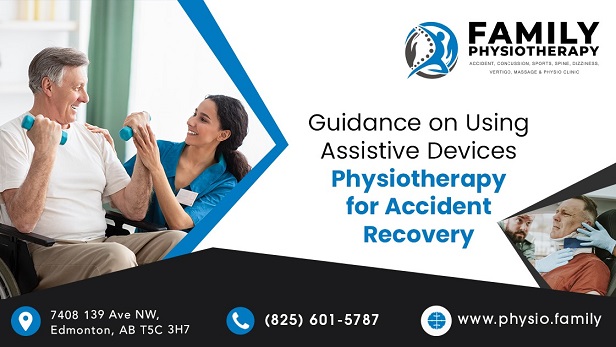Accidents happen when you least expect them, and they often leave more than just a few scrapes and bruises. Motor vehicle accidents (MVA), in particular, can result in serious injuries, leaving individuals with mobility issues, pain, and a long rehabilitation process ahead. Whether the injury is minor or severe, motor vehicle accident physiotherapy in Edmonton incorporates assistive devices that can significantly speed up recovery and improve overall outcomes. But, it’s important to understand how to use these devices correctly to maximize their benefits.
Why Assistive Devices Matter in Recovery
Assistive devices are designed to support individuals during their recovery process, allowing them to regain strength and mobility while decreasing the risk of further injury. Assistive Devices not only provide physical support but also enhance confidence, enabling patients to move around more freely. During MVA physical therapy, assistive devices often serve as temporary aids that assist in healing while patients work on regaining their full range of motion.
Benefits of Assistive Devices:
- Pain Reduction: Assistive devices reduce the weight and pressure placed on injured areas, relieving pain and allowing damaged tissues to heal more effectively.
- Improved Mobility: With tools like walkers or crutches, individuals can preserve their independence and stay active while recovering, avoiding complications from immobility.
- Reduced Risk of Re-Injury: By stabilizing joints and providing support, assistive devices prevent unnecessary strain on injured areas, which can reduce the chance of setbacks or additional injuries during rehabilitation.
Common Assistive Devices Used in Physiotherapy
Each injury requires a unique approach, and the choice of assistive device depends on the nature of the injury, its severity, and the patient’s specific needs. Some of the most commonly used assistive devices in motor vehicle accident physiotherapy are:
1. Crutches
Crutches are perhaps the most well-known assistive device for lower body injuries. They are often used when patients need to maintain weight off an injured leg or foot, allowing healing without placing strain on the affected area. Proper use of crutches is critical; incorrect technique can lead to further discomfort or injury, so it’s important to learn the right way to walk with crutches under the guidance of a physiotherapist.
2. Walkers and Rollators
For individuals who need more stability than crutches can provide, walkers or rollators are a good alternative. These devices are equipped with a frame that the patient can lean on for support, making them ideal for those with balance issues or severe injuries affecting both legs. Walkers allow for gradual weight-bearing and are often used as a transitional tool as patients regain strength in their lower limbs.
3. Canes
Canes are a great option for individuals who have recovered to the point where they can bear weight on the injured leg but still need some extra stability. They are less cumbersome than crutches or walkers and are often used in the later stages of motor vehicle accident physiotherapy. Using a cane correctly involves positioning it on the opposite side of the injured leg to ensure maximum support and balance.
4. Braces and Splints
Braces and splints are used to stabilize injured joints, such as knees, ankles, wrists, or shoulders. These devices restrict movement, preventing re-injury while the body heals. For example, a knee brace can be used during recovery from a torn ligament, providing necessary support while allowing the patient to engage in controlled movements during physiotherapy exercises.
5. Wheelchairs
In cases of severe injury where mobility is significantly restricted, a wheelchair might be required, either temporarily or permanently. Wheelchairs allow individuals to maintain independence while preventing further injury to areas that need healing. Physiotherapists often incorporate wheelchair training to ensure that patients can use the device safely, reducing the risk of overexertion or strain on their upper body muscles.
Tips for Using Assistive Devices Correctly
Although assistive devices are immensely beneficial, using them improperly can cause complications or even exacerbate existing injuries. Motor vehicle accident physiotherapy in Edmonton offers essential tips for getting the most out of your assistive device during a car accident.
1. Consult with a Physiotherapist
Before using any assistive device, it’s crucial to work closely with a physiotherapist who can recommend the right tool based on your injury. A professional will also ensure you understand how to use the device correctly, from adjusting its height to mastering proper walking or movement techniques.
2. Practice Proper Posture
Whether using crutches, a walker, or a cane, posture is key. Hunching over or leaning too heavily on your device can lead to discomfort or long-term musculoskeletal issues. Make sure you’re standing upright, distributing your weight evenly, and not over-relying on the device for support.
3. Take it Slow
Recovery is a marathon, not a sprint. Don’t rush the process by trying to move faster than you’re capable of. Moving too quickly or placing too much pressure on the injured area can delay healing or cause additional damage. Follow the pace recommended by your physiotherapist and allow your body the time it needs to heal properly.
4. Keep Devices Clean and Well-Maintained
Assistive devices can wear down with daily use, so it’s important to regularly inspect them for damage. Crutches with worn-out grips or walkers with loose screws can be dangerous. Ensure that all parts of your device are in good condition to avoid accidents or additional strain during rehabilitation.
Accelerating Recovery with the Right Support:
The road to recovery after a car accident can be challenging, but with the right tools and guidance, it’s entirely possible to regain strength and mobility. Assistive devices are essential in this process, helping patients recover safely and efficiently.
For those seeking professional support during recovery, Family Physiotherapy in Edmonton offers comprehensive services tailored to your needs, ensuring you get the best care possible. Whether you’re facing minor injuries or severe impairments, motor vehicle accident physiotherapy in Edmonton helps you navigate your journey with assurance and care.

